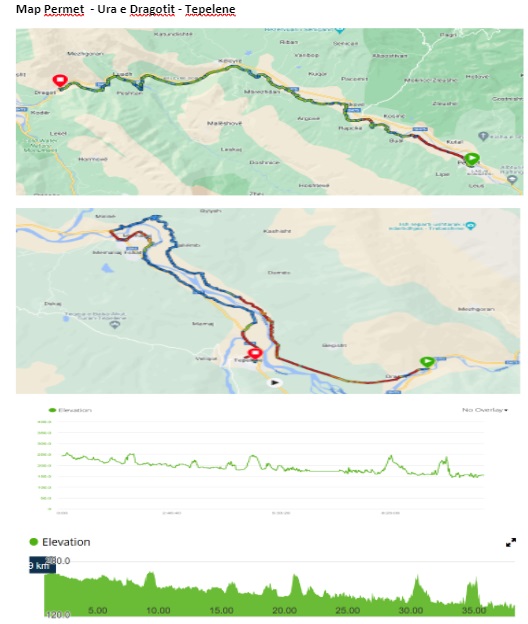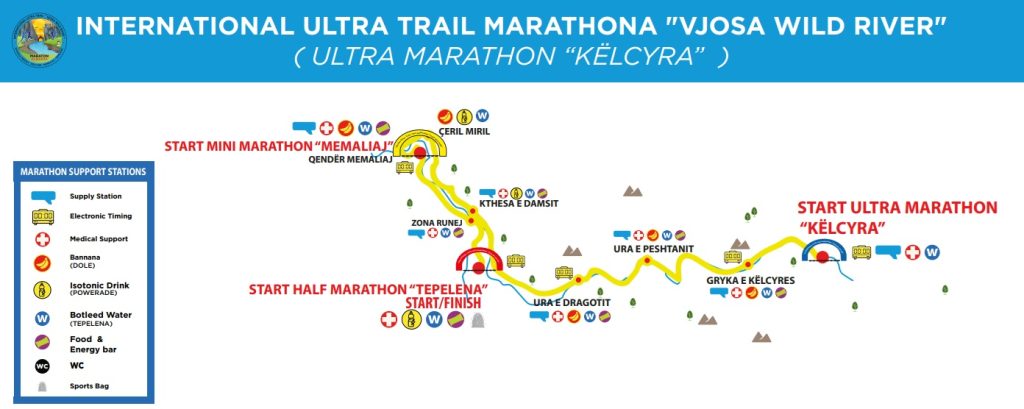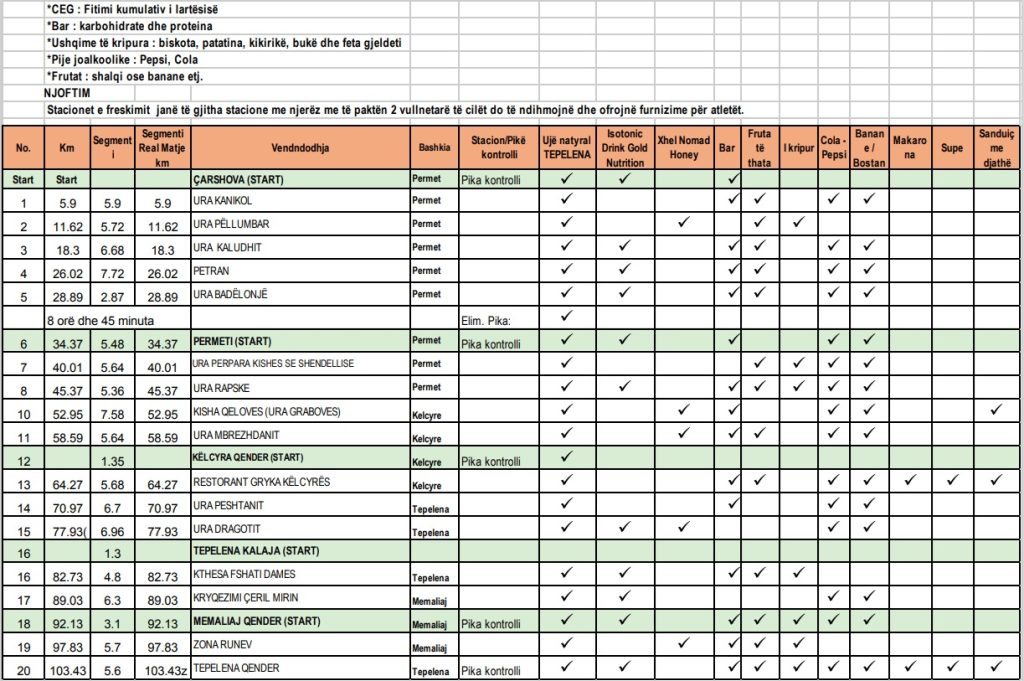Goes through the city of Këlcyrë, Memaliaj, Tepelenë. Ultra Trail “Vjosa Wild River” 44 Km.
“Kelcyra” is a classic ultra trail race of 44 Km and an elevation gain of about 327 m. It starts at 09:00 with a total time limit of 12 hours, including 1 intermediate break point (elimination).

A maximum of 100 athletes can participate in the race.
Ura e Dragotit: 6 hrs after your designated start time (exit from the station)
12 hours since the race start.
The station in between, bags with clothes, Gryka Kelcyres restaurants.

The marathon path follows the “Wild Vjosa” river, renowned for its rich cultural and historical significance. It aims to unite Albanian-speaking territories in the Balkans and establish intercontinental connections across Europe. The route is entirely terrestrial, featuring soft terrain with minor elevation changes. It has been carefully cleared of dense vegetation and other obstacles, making it a smooth, scenic journey.
A welcoming event the day before the marathon in the city of Tepelenë with traditional folk songs and featuring a “Pasta Party”, tranquil accommodation in camps and hotels, and stops for active vacations.
Starting from the administrative unit of Çarshovë, the route follows the Vjosa River on the right-hand side, winding closer to and further away from the riverbed, depending on the natural terrain shaped by centuries of river erosion. Along this stretch, the path connects several picturesque villages, such as Zhepe, Dracovë, Kanikol, Pellumbár, Strembec, Ura Kaludhit, and Petran. As the route heads towards the city of Përmet, the landscape transitions from plains to rolling hills. Rest stations are available every 5–7 km, offering water, fruits, soft drinks, and snacks. Runners will also pass through flower-lined streets as they approach the center of Përmet.
Leaving Përmet, the route leads to meadows with vineyards and vegetable fields near the villages of Kutal, Kosinë, and Piskovë. Participants will also pass the stunning Qelova Church near Grabova Bridge, continuing along gentle hills that overlook the beautiful Vjosa River and surrounding landscapes.
Next, the trail reaches the Këlcyrës Gorge, where the cool air and crystal-clear springs offer refreshment. A lunch break at local restaurants within the gorge will provide participants with delicious regional dishes and fresh water. After the break, the route continues toward the mouth of Mezhgoran, with runners passing through lush greenery and cold water springs before arriving at the Peshtan Bridge and, finally, the historic Dragot Bridge.
The 67 km route from Çarshovë to Dragot Bridge is entirely pedestrian-friendly, designed exclusively for runners and walkers to enjoy the untouched beauty of the region. After crossing Dragot Bridge, the path shifts to the left-hand side of the river, leading runners through pine-covered hills toward Memaliaj. From the center of Memaliaj, the trail then runs in the opposite direction of the Vjosa River’s flow, guiding participants to the city of Tepelenë and its historic fortress, through a completely green path.
The path only connects with the highway through pedestrian footbridges, spaced approximately 6–8 km apart. Even during periods of low water flow, the Vjosa River is impassable to pedestrians due to its strong currents and cold springs. From the trail, runners will be able to see the distant highway on the other side of the river.
Cultural and Historical Experience
The marathon provides participants with the opportunity to explore and appreciate the rich cultural and historical values of the cities along the route. This event is not merely a sports challenge but also a journey through time, designed to unite tourism, sports, culture, and health into a single experience.
A list of historical and cultural landmarks to visit during the participants’ stay will be available on the marathon’s website. Additionally, informational sheets in each runner’s bag will detail the tourist sites of interest along the route, encouraging runners to immerse themselves in the local culture.
The event will evoke emotions during the warm days of September and October, providing both a mental and physical health experience that is deeply relevant in today’s fast-paced world.
The marathon schedule and routes have been meticulously planned by the association “Maraton Albania” and officially approved by the municipalities of Tepelenë, Memaliaj, Këlcyrë, Përmet, and the administrative unit of Çarshovë. The routes adhere to standard lengths and have been carefully measured by experts from “Maraton Albania,” ensuring the placement of rest stations in accordance with trail marathon requirements for athletics.
This sports event, as outlined in the project, will be organized and conducted in full compliance with the principles, conditions, and criteria established by Law No. 79/2017 “On Sports,” as amended.
Running especially when that includes long distances, time and effort is inextricably intertwined with energy intake. The importance of energy intake during an ultra marathon, for those who have such great racing experience, seems to be the key for a desired result, which focuses not only on performance but also on pleasure offered by the race and yet avoiding the phenomenon of survival.
Basic rationale of the group responsible for the supply of our race is to provide participants with a variety of flavors, satisfying even the most demanding requests. The selection of various food items for the refreshment stations is based on specific guidelines that allow athletes to meet their energy needs.
Particular emphasis is given on energy coverage for novice runners, who can participate without dietary protocol, preventing energy loss that could arise from the lack of racing experience.
The proposed selection and placement of items provided in the refreshment stationss designed to meet energy needs in accordance with international recommendations and the relevant scientific literature.
Each mountain race is unique, yet each and every athlete is unique. The intra-individual differences among athletes are numerous and so are their needs.
Thefort to satisfy them, at least at the energy level is an incentive for all of us.
The selection of the particular food items for the refreshment stations was based on our personal engagement with sport nutrition and the creation of similar protocols for our athletes. Your views and feedback on this issue were also taken into consideration.

Each athlete has the right to carry the equipment they consider necessary to cope with the challenges of the race. The organization reserves the right to conduct random checks to ensure the completeness of the equipment both at the start and during the race.
We recommend a minimum equipment, called “Survival Gear,” which is absolutely necessary for an athlete competing for so many consecutive hours.
The suggested “Survival Gear” package consists of the following:
In addition to the above equipment, each athlete can add vital medications they may need, as well as other practical items, such as:
Recommented/Optional equipment
We recommend recommends that athletes carry a small backpack or waist pack with some basic supplies, such as: